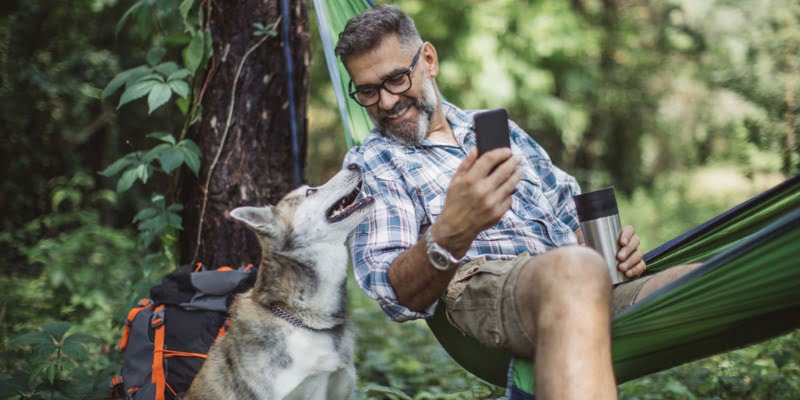
Camping with your furry friend can be an incredibly rewarding experience. The wilderness offers a wealth of sights, scents, and activities that can ignite your dog’s senses and provide them with a unique sense of freedom.
However, ensuring a successful and enjoyable camping trip with your dog requires careful planning and consideration. Today, I will unveil the essential tips that come with camping alongside your canine companion, and highlight the crucial points you should keep in mind.
However, before you set off on your adventure, remember that every dog is unique. Some may be seasoned outdoor enthusiasts, while others might be experiencing nature for the first time. So never start your vacation trip with dogs unprepared! This will save you, your fellow campers, and your four-legged friend from unnecessary stress.
Tips for Camping with Your Dog
Let’s break down the 13 tips for camping with dogs step by step…
1. Securing Dogs While Driving
It’s important to remember that you have a legal obligation to ensure the well-being and safety of your dog. Your dog must neither slip nor fall over in the security system. Your four-legged friend is legally regarded as a “charge” – even if that may sound a little heartless. Animals or the cargo must not pose a risk to road safety – the cargo must also be in accordance with the regulations.
The best safety system for transport is a (permanently installed) dog transport box that has no play in any direction. Alternatively, you can also find out about mobile home extensions for dogs. These are significantly more expensive and time-consuming depending on the vehicle. However, because they are custom-made and designed for the camper, we highly recommend them.
If you are traveling with the RV instead, you should generally not transport the dog in the RV. The main reason is that, as a person, you are not allowed to travel in the RV, and therefore, you don’t know how your four-legged friend is doing in the RV.
2. Make Sure Your dog is Allowed on the Campsite
No matter what breed, every dog whose mistress or master can comply with the house rules of the campsite, is normally welcome. Since that depends heavily on the campsite itself, no general statements can be made about it. If you are unsure, ask directly at the campsite.
It is best to find out about the rules of the campsite during the planning phase or ask the campsite authority. This step should be done before making the campsite selection and make sure to clarify whether your favorite campsite really allows dogs in the motorhome or in the tent. The reason is there are some places where dogs are not allowed in the tent, but they are in the RV.
3. Choose Dog-friendly Camping and Parking Spaces
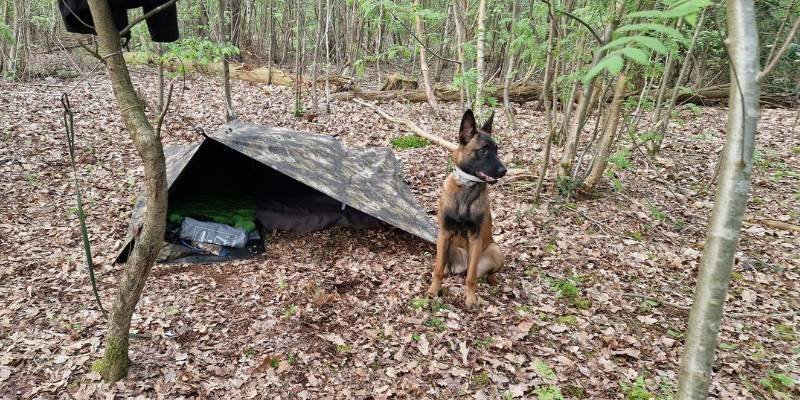
You probably agree with me: Just because you found a campsite that allows dogs doesn’t mean that much about dog friendliness, does it? The solution is simple at first. If it is important to you to be able to run out, ask directly at the campsite.
The same applies to possible activities such as dog training or dog walking. Some places are sparing with such specific information about the local conditions. If you spend a few minutes before booking, you can save yourself and your furry friend from a few unpleasant situations!
However, you will rarely find campsites where your four-legged friend can vacation for free. Make sure to simplify where you can go for a walk. You should be aware that the leash obligation always applies. You can even stumble across supposedly simple things like the walk to the sanitary facilities:
Do you take your dog with you when you go to the morning toilet to combine elegantly it with walking? In that case, you should find hooks for the leashes in really dog-friendly places.
Or not?
Perhaps we see this too critically, but the dog-friendly campsite is unfortunately relative. Nonetheless, the essence of this tip is clear:: Be critical when choosing your vacation spot!
4. Pay Attention to the Underground of the Campsite
Many campsite operators mean well – also when it comes to the choice of their floors. They use gravel as a substrate, which certainly promises advantages in terms of durability and easy replacement.
However, hard floors such as coarse gravel are not good for the dog. They hurt their paws. The balls of the feet can be injured. Think of it as if you were walking barefoot. That hurts a lot depending on the surface. So watch out for places that are mostly grassy. Your four-legged friend will thank you when he can frolic around carefree! You can leave out shoes too.
5. Plan Activities for Camping with Your Dog
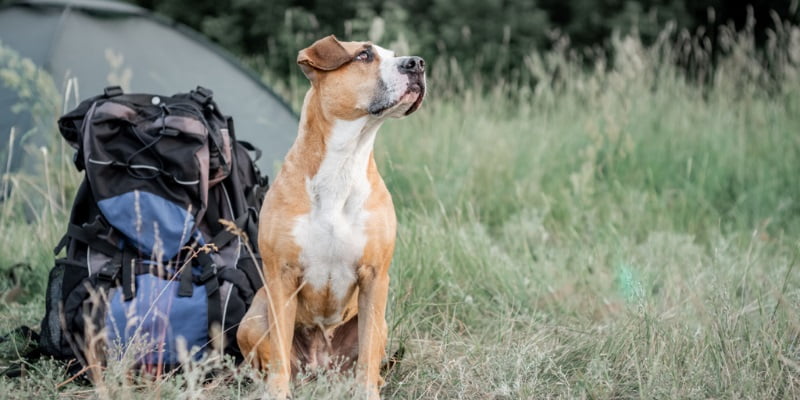
This advice isn’t just for your furry friend! As a pet owner, it’s crucial to take some time to relax and unwind. Keep in mind that some leisure activities may have limitations when you have your dog along. For instance, if you’re considering visiting a museum, please be aware that dogs might not be allowed or there might be a general prohibition.
Be sure to choose plenty of outdoor activities. Do you want to go to the cinema? Try to find an outdoor cinema nearby where dogs are allowed. If you regularly go to the restaurant, find out where four-legged friends are allowed and where not. Dogs are allowed in many locations – but not in all. You can find this out by doing good research before going on holiday.
Regular hikes are also great, especially because they are easy to plan before you start your journey. Thanks to extensive online maps, this is not a problem these days. If you have a campsite by a lake or by the sea, the possibilities are more diverse anyway.
6. Get Your Dog Used to Dog Accessories
Not only the luggage is important, but I recommend using the checklists at the end of this article. I have already reported on useful dog accessories for camping elsewhere. You should definitely give your beloved four-legged friend some time to get used to the new accessories.
It is therefore best to put it through its paces before you start your journey. If you are planning a camping holiday, give the dog sleeping bag a try. If you’ve got yourself a peg, ram it into the grass floor in the park.
The more equipment you test for your dog beforehand, the better! In stressful situations, your dog will stick to the things he knows more than to completely new accessories. Especially when the entire environment is completely new.
7. Let’s Discuss Where Your Dog will Sleep
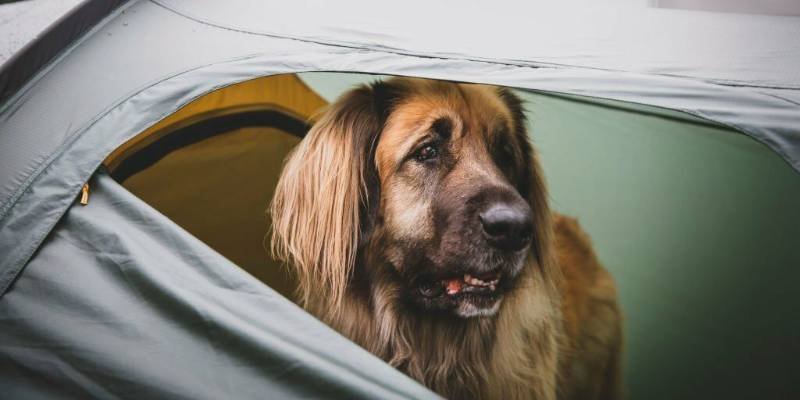
Camping vehicle or tent, dog sleeping bag or dog bed: Depending on the vacation and duration, think about where your dog should sleep when camping. If the animal sleeps in the tent, there are several options: A sleeping mat and his favorite blanket are proven solutions. Just give it a try, preferably before you start your journey. When camping with dogs, make sure that the dog does not freeze. Dog sleeping bags also perform well in the cold.
- Do you want more information on this topic? Take a look at our tips on how to keep your four-legged friends warm while camping.
If you are planning a motorhome holiday with your dog, a dog bed or dog sofa is ideal for the motorhome. Put his favorite blanket over the new piece of furniture, then you will quickly get him used to his sleeping place in the camper. The blanket also warms him from below when it gets cold at night.
If it is a dog sofa or dog bed, it is best to get a washable synthetic leather one, which you can throw the cover into the machine. Put the dog bed under the table. Because let’s be honest – if your dog constantly blocks the way because he’s lying in the corridor, you will eventually get upset.
If he doesn’t like new people and you get to know new fellow campers, there are places to sleep in the rear area. You could put a dog blanket on the bed or under a bench if that doesn’t bother you. For summer trips, think of hot days and plan a cooling mat. This will help your fur nose fall asleep if you put him under his blanket.
8. Get Your Dog Used to Your Camping Vehicle
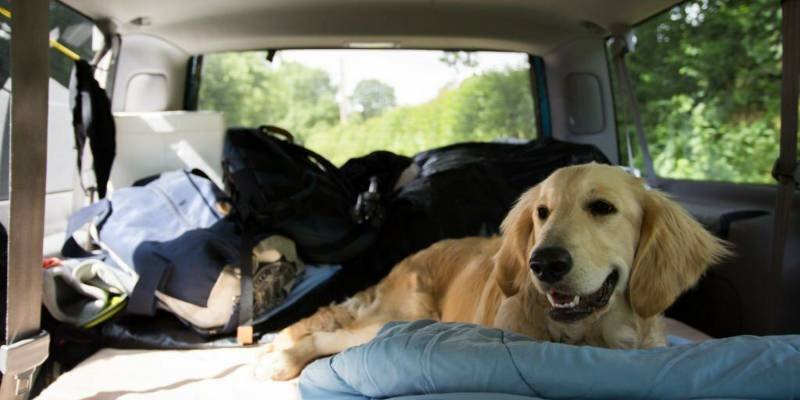
Some dogs love it, others hate it – they’re scared or get motion sickness. Driving with a dog is best practiced long before going to the holiday destination. The same applies to motorhomes and RVs. A knock-out action won’t help you, it would only increase the travel problem.
Much worse:
It would take away the possibility of designing the car or camper as a place of retreat. Whenever your fur nose is afraid, the camper should be the first choice to let the built-up stress subside. You should plan driving in a lot of small steps and always make it positive. The smaller the steps, the greater the chances of success you have.
You start by slowly leading the dog to the vehicle and letting it do “its thing” – whatever that is. Sniffing, exploring the campervan – give it the space it needs. Once that’s done, you can put your favorite things, toys, or blankets in the vehicle. This is how you combine the tried and tested with the unknown.
Perhaps he will now voluntarily lay down in the vehicle when you open it. Then you can always go on longer, nice, and positive short trips with your dog.
9. Plan the Trip with Your Dog to Your Destination
Camping with a dog doesn’t just start on site. Take a close look at your planned travel route in advance. Let’s see what you need to look out for when planning an itinerary for camping with a dog…
- Make sure you take regular breaks and choose good motorway service stations if they are on your route.
- Use Google Maps to plan your route, create your own markings along the route and save them in your device.
- If you have little experience with camping vehicles, plan carefully and conservatively. This also includes marking traffic jams in known problem areas or memorizing them.
- Take your time on the ride and take it easy and calm. If you notice that your dog is under stress, take longer breaks in traffic-calmed places. Give your dog the time it needs.
- Avoid getting upset as much as possible while driving. Even if the other road users are driving badly because of the excitement, you should not pass the stress on to your dog. Your four-legged friend will notice when you are nervous and react accordingly.
10. Avoid Noisy Environment
Your dog usually doesn’t like loud, unfamiliar surroundings. For this reason, pet camp tent is not a good choice for camping with your dog friends. If you use a tent for dog camping, you have to keep a few things in mind. There is, for example, the issue of the noise level.
Loud noises disturb camping with a dog:
- Getting used to the tent also depends on how loud it is. The tent itself does not offer the dog any protection from noise. It may well be that the first few nights are restless.
- Offer your dog a place of retreat, for example the car. It can be any place with which he or she associates positive experiences.
- Provided you have enough patience, your four-legged friend will get used to the strange noises when camping.
Note the conditions outside the tent:
- Choose an area around the edge where it isn’t quite as loud.
- If you are camping at a festival with your dog, stay out of noisy groups.
- Avoid areas where music is often played. It could be that the “DJ” turns up the volume control.
- Avoid the area of drunk people, they too can get very loud or react uncontrollably.
Thunderstorms are a problem when camping with a dog. Neither you nor your dog is protected and nobody is really comfortable. You may be lucky that the dog doesn’t react so anxiously to lightning or thunder.
But what about you?
If you feel uncomfortable, the area around the tent doesn’t suit your dog. It becomes uncomfortable for both of you. Your dog will notice when you are afraid. It is therefore best to look for a safe retreat in the car when camping during a thunderstorm.
11. With a Dog in the Tent – This is How It Works
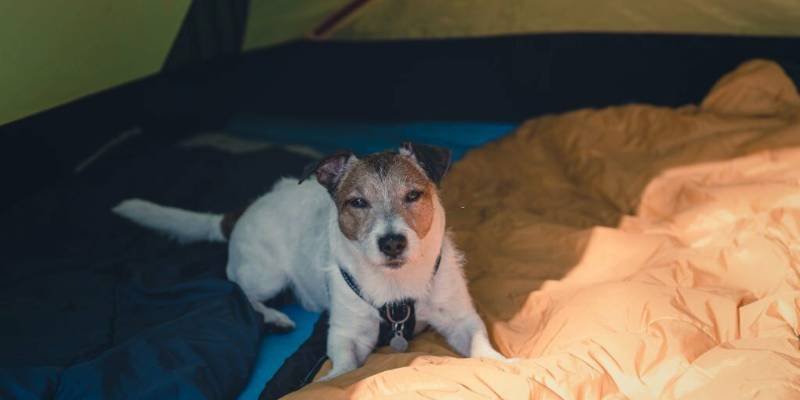
Ask yourself how big the outdoor dog camping tent needs to be.
Did you clarify that dogs are allowed in the tent? If so, first pay attention to the extent to which there is a separation between normal camping guests and those with dogs. Even if dogs are allowed in the tent, it also depends on where exactly the pitches or tent sites are for camping with a dog. After all, there are campsites where you and your four-legged friend would have to camp on the edge of the site.
Many operators do this in order to deport the supposedly Unwanted or Problematic guests with dogs. That doesn’t sound very inviting when you think about it. If the pitch is on the edge, camping with a dog can of course also has advantages. For example, these types of areas are often shady and are a great way to escape the heat in summer.
On the other hand, if the peripheral area is bare and dirty, or if you actually have an uncomfortable feeling of being unwelcome as a “peripheral guest”, you better stay away from it! Take a look at the pitch in advance, have photos sent to you, or ask in forums whether someone has already gained experience camping with a dog there.
Pay attention to the size of the tent:
- If you have a large dog, 2-person tents are too cramped. Better to choose a larger family tent right away.
- You should also attach the required tent size to the luggage and dog accessories as well as the length of the vacation.
When you arrive in the tent with your dog, please note the following points:
- Give your dog time to adjust to the unfamiliar environment.
Close the tent completely so that your dog cannot unintentionally donate. - Try out the tent with your dog before you go on holiday. This reduces the stress for everyone involved.
- Your dog is initially more alert and curious in the tent, this is quite normal.
- Keep calm and signal to him at all times that everything is fine. Then at some point, the dog will relax.
12. When the Dog Barks on the Campsite
First of all, it is important to ask why your dog is barking. Here are the common reasons for barking:
- stress
- Overstimulation
- Too little attention
- boredom
- Afraid of the new environment
- Fear of strangers
- Territorial behavior
Depending on what the reason is, you can react differently. If there are too many new stimuli, he needs to be quiet. One solution would be a good retreat that he knows – such as the car.
If he is stressed, chewing can help him relax. If many unfamiliar fellow campers pass by your camping vehicle, a privacy screen often helps. It can also help to take him to the motorhome for a while if strangers make your four-legged friend aggressive.
However, it is not a good idea to leave your furry friend alone at the campsite for a long. Depending on how the dog is brought up, you will be able to do that. You should keep in mind that the new environment is still stressful for him. If he becomes increasingly nervous, he will bark despite being well-trained. Especially when other guests walk past the tent or mobile home. This means that it is best to always plan your activities with a dog.
In general, you can assume that not every guest reacts as positively to dogs as you do! It should be clear that you show mutual consideration. If you have your fur nose under control and if he is well-behaved, he will normally not do his business at the campsite.
Go for a walk with him outside the premises, even in the small shops. But don’t put yourself under pressure to do everything right. You are human and have the same right to a relaxing holiday as your fellow campers without a dog. So even if something goes wrong, a mishap happens and the dog barks. This is only human (or animal) and shouldn’t spoil your day.
After all, do you understand when your camping guests next door have loud children or a party lasts longer? I believe that mutual tolerance is part of relaxed camping.
Here is another general tip: If your dog has been quiet for a while and not barking, reward him regularly in such situations. Don’t take it for granted when he’s calm.
13. Make Checklists for Camping with Dogs
Before you start, I recommend you make your own list of what you still have to do with your dog before going on holiday and use our checklists for timely shopping, packing suitcases, or visits to the vet. First of all, it is very important to have a first-aid kit with durable contents. Make sure to buy a first aid kit that is specially designed for dogs.
But what if you are unsure how to use something in a minor accident? There is a special emergency list for this, which is within easy reach of the first-aid kit. A good first-aid kit for camping with your dog should include the following:
- Tick protection
- Means for deworming
- Flea agent
- Something against travel sickness
- Against poisoning
- Eye ointment or eye drops
- Diarrhea medication
- Remedies against insect bites and against itching
- Painkiller
- Sedatives
- Disinfectant spray
Questions to the operator about choosing a campsite
- Are dogs generally allowed on site?
- Are dogs not only allowed in the camping vehicle but also in the tent?
- Campsite choice: What is the overall added value for dogs?
- Are there opportunities for exercise, dog sitters, a dog hotel, dog school, dog beach, or dog meadow nearby?
- Where can a dog owner go for a walk with four-legged friends?
- Are there sufficient eyelets on the outside of the facilities on site (e.g. sanitary facilities) for attaching the lines?
- Are the dog places separated from those of the other guests?
- Where exactly are the tent sites and pitches for guests with dogs (peripheral areas, centrally located)?
- Does the campsite have shaded spaces and are they available?
- Is there water nearby, for example, a lake or the sea?
- What is the soil quality like on site? Are the floors hard or soft?
- What are the extra costs for guests with dogs?
Do this long before you start your journey
- Papers: Always carry valid dog papers with you!
- If border papers are required, get them and register your dog at the campsite.
- Find out about the entry requirements for your holiday country.
- Have your EU pet passport ready. If you don’t have one, get one issued in good time.
- Check your animal liability insurance in good time.
- Depending on the country, a health certificate for the dog may be required. Request this in good time.
- Remember to get vaccinations well in advance. Especially if you are traveling to countries outside the EU.
- Prophylaxis should be given well in advance.
Checklist for camping with dog camping
- Treats
- Chew sticks
- Small water bottle
- Small bowl and food for puppies
- Fleece blanket for resting and drying after walks
- towels
- Kitchen rolls
- Enough poop bags
- Disinfectant spray
- Favorite toy
Travel-friendly accessories for four-legged friends
- Water for the vacation trip (better take more with you!)
- Stock up on dog food, wet and dry
- Treats and chew sticks
- Water bowl
- Food bowl
- Can opener for the feed
- Dog leashes
- Collar with address and mobile phone number
- Depending on the country: muzzle
- Dog basket
- Dog blankets
- Old towels and sheets
- Dog brush and grooming supplies
- Transport box
- Leash attachment for the camper
- Toys for the dog
- Take all the necessary papers with you (see checklist “Before you start your journey” above)
Conclusion
As I mentioned beginning of this guide, a safe and enjoyable camping experience with your dog relies on thoughtful preparation and attentive care. By taking all these steps discussed above, you can ensure that your camping trip with your four-legged friend is not only safe but also a memorable bonding experience for both of you.